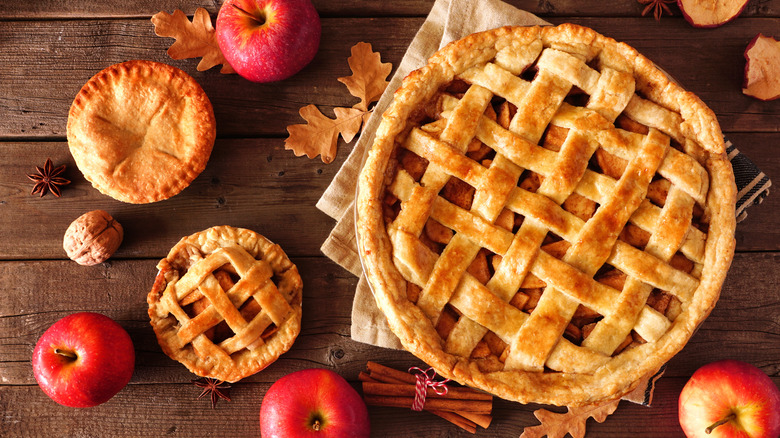Boiled Cider Is The Key Ingredient For The Ultimate Apple Pie
Nothing marks the change of the seasons quite like apple pie — it's a symbol of fall, of Americana, of wholesomeness. It's also, of course, a dessert — and a tasty one at that. It's such a staple that, if you're an avid baker, you probably already have your own favorite recipe. It might be time to revise your go-to, though, because there's one secret apple pie ingredient that will put yours a crust above the rest, and it's one you may never have even considered: Boiled apple cider, also sometimes called apple molasses.
This ingredient is just cider that's been boiled down into a thick syrup, so it ends up having a very concentrated flavor. You can buy it or make your own, and it's the perfect way to add an autumnal touch to all sorts of dishes. You can drizzle it over pancakes or anywhere else you might use maple syrup, add it to tea or cocktails, and bake all sorts of sweet treats with it, including but certainly not limited to apple pie.
The only ingredient in boiled apple cider is, well, apple cider (and maybe some spices), so it's great to have on hand when you want a lot of flavor without additives or dyes. Its roots are in colonial New England and althought it's not the household staple it was a few hundred years ago, it's still worth rediscovering — and it could make your apple pie the most sumptuous confection on the dessert table this Thanksgiving.
To buy or to boil
Unlike a century ago, today, boiled apple cider is kind of a niche product, so you may not find it on the shelves of your regular grocery store. There are only a handful of producers that even make it anymore, so you might need to go online to buy some (unless of course you live in a charming, frozen-in-time village in Vermont, in which case, lucky you).
Alternatively, you can make your own boiled cider at home. Literally all it takes is boiling apple cider on the stove until it takes on a syrupy consistency. Start with pure cider (skip anything artificially flavored, if possible) and pour it into a stock pot that's much bigger than whatever quantity of cider you're using, so there's plenty of room for it to bubble without boiling over. Turn the heat up high, and once it reaches a boil, turn it way back down to medium-low so that it'll simmer, not burn.
Chefs and recipe developers have different takes on how much it's supposed to reduce — anywhere from ⅓ to 1/7 its original volume — and thus how long to let it boil, with advice ranging from three to eight hours. It's fine if you're not following a specific recipe; just keep an eye on it and stir periodically to make sure it's boiling consistently and not burning at the bottom or sides of the pot.
The apple pie to end them all
Once you have your "apple molasses," either homemade or store-bought, you have the secret ingredient to making your best apple pie ever. After combining all the other ingredients for your pie filling, mix in about ¼ cup boiled cider before assembling it all inside the unbaked crust. The result is going to be a pie with a super rich, powerful apple flavor with seasonal sweetness and tang in every bite — no bland, slimy filling here.
Classic apple pie is just one of endless ways to use boiled cider in baking. You could also whip it into a glaze for cakes and other confections by combining the syrup with confectioner's sugar and milk or cream, or add a few tablespoons to cake batter or cookie dough to give other baked goods a strong kick of distinctively apple flavor.
You can also skip baking applications altogether and use the boiled cider to top apple-cinnamon pancakes, vanilla ice cream, or anything else that could benefit from an injection of formidably fruity flavor. Or, use it simply as apple cider concentrate (which is sometimes how it's labeled) by adding a generous spoonful to hot water. You'll have a delicious winter warmer in just the time it takes your kettle to boil.


